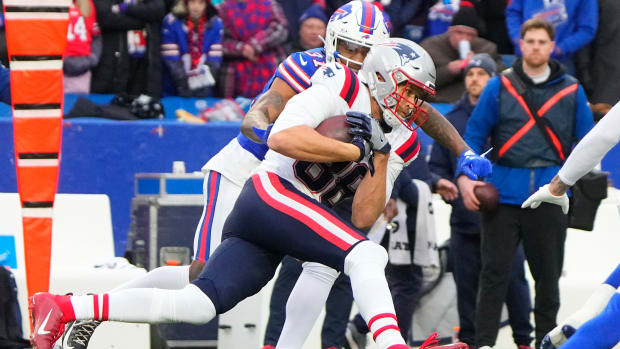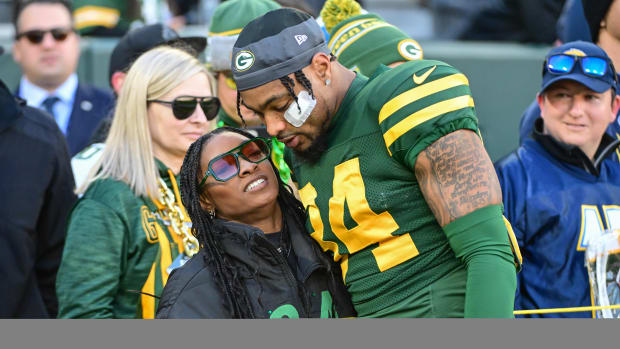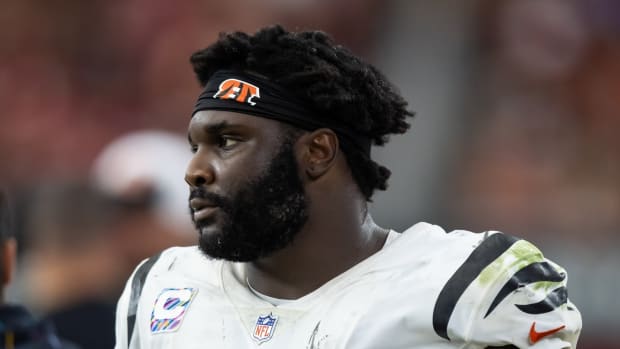The Two Quarterback Misses That Led to Frank Reich’s Firing
Nine weeks down, nine weeks to go, and a pretty newsworthy Monday at the turn…
• The easiest place to start when doing an autopsy on the Frank Reich era in Indianapolis is the most important position on the field—and there’s no question that Reich and Colts GM Chris Ballard were dealt a crappy hand there after quarterback Andrew Luck’s shocking retirement in the summer of 2019.
It made sense, then, that the Colts got time to recalibrate at quarterback after that, especially given that they were a team built well past the point where they’d be failing into top-five picks.
But you don’t get forever. There are a couple high-end misses that marked Jim Irsay’s decision to fire Reich on Monday, both of them coming in the offseason of 2021, after Luck had been been gone for 18 months. (You can give them a pass for not moving up to get one in ’20, when they used the 12th pick to trade for DeForest Buckner instead, since Luck had just departed.)
The first miss was on Matthew Stafford. When working with the Lions on his trade request, Stafford’s camp gave the new Detroit management three teams he’d favor in a trade—the Rams, 49ers and Colts. It’s why very solid offers from Washington (the 19th pick and a third-rounder) and Carolina (the eighth pick, a fifth-rounder and Teddy Bridgewater) were quickly rebuffed.
Ultimately, the Colts never put their first-rounder, the 21st pick, on the table, and the Niners never made a hard offer, which allowed for the Rams to close in quickly. The Colts wound up with Carson Wentz. The Niners wound up with Trey Lance. The Rams wound up with a Lombardi Trophy.
And when Indy went after Wentz, they chose to trade a 2021 third-rounder and ’22 first-rounder, rather than trading up for Ohio State’s Justin Fields (who was a very real consideration for Ballard and Reich early in the process). The Colts wound up using the 21st pick to take Michigan pass-rusher Kwity Paye, while the Bears used the 20th pick to move up and take Fields.
We’ll see how history winds up looking at all of that. But if there’s a regret for Reich, I’d imagine it’s in how he and the Colts opted for half-measures in three straight post-Luck offseasons, rather than finding a guy (be it in the draft in 2020 or ’21, or with a vet like Stafford) to go all in on.
• There’s no question that decision making was a major part of how Irsay came to his decision here. His impatience bled through in January and February as the call to cut ties with Wentz was pushed along, and it’s been felt throughout that building since the team’s ugly loss to a really bad Jaguars team in Week 18 of last year.
And there’s a strong feeling there that Irsay’s fingerprints were all over the team’s decision to pull the plug on Matt Ryan (and go to Sam Ehlinger) a couple weeks ago, with the owner’s increasing desire to settle the position once and for all well-established. Ehlinger’s elevation, the thinking went, would lead to one of two conclusions: Either they’d really have something, or he’d fall on his face and help position the team to draft one in April.
OC Marcus Brady was fired after that move, stunning the coaching staff and angering some who thought Reich should’ve done more to stick up for the respected Brady. Which, of course, only raised the tension within a staff that had already been remade twice in the last two years, following the departures of coordinators Nick Sirianni and Matt Eberflus.
Now, Reich is out, Jeff Saturday is in and the future of the organization is in flux. Irsay’s said to have been enamored by Saturday’s potential for a while now, and the former Colts center was a presence at training camp in the summer. How the rest of a veteran staff responds to him will be interesting, given that all their careers are now also in flux, and they’ll be answering to someone who’s only ever coached at the high-school level.
But Saturday will get a shot now to prove that he can make like Deion Sanders at Jackson State and work through the logistical challenges that are presented to someone without experience.
Meanwhile, it’s pretty clear how hands-on Irsay will be in shaping where the Colts go from here (maybe a call to Peyton Manning is coming next), based on how he’s run the team since the end of last year. For better or worse, this will be his show.
• One last thing on the Colts: The deterioration of the offensive line played no small part in what’s happened over the last few weeks, and so the numbers I’m about to present (via Spotrac) should get your attention. Here are the teams with the highest cap-dollar allocations in their offensive lines for 2022 …
1. Colts: $41.54 million (19.5% of the adjusted cap).
2. Eagles: $37.30 million (16.6%).
3. Ravens: $34.88 million (17.0%).
4. Cardinals: $34.87 million (16.8%).
5. Lions: $34.14 million (15.7%).
To get there, Indy gave center Ryan Kelly, guard Quenton Nelson, and tackle Braden Smith monster deals—all of which were deserved. But the other spots, one of them notably being left tackle, were left to rot from the inside out. And in a lot of ways the situation at left tackle mirrored what has happened at quarterback, with a lot of failed half-measures taken after the retirement of Anthony Constonzo leaving a mess of a premium position.
Bottom line, with how Ryan and Ehlinger have been knocked around, or how the Colts’ run game—once among the NFL’s best—has collapsed, you’d think Indy was neglecting its offensive line altogether. What’s actually happened might be worse.
• Since there are now two jobs open, I thought I’d attack something that’s going to be a big topic come hiring season: the backlog of quality defensive candidates out there in an environment that has skewed big-time toward hiring offense as of late.
On that list, for me, would be the Patriots' DeMeco Ryans, Cowboys' Dan Quinn, Eagles’ Jonathan Gannon, Broncos’ Ejiro Evero, Raiders’ Pat Graham, Rams’ Raheem Morris, Cardinals’ Vance Joseph, Patriots’ Jerod Mayo, Bills’ Leslie Frazier, Bengals’ Lou Anarumo and the Giants’ Wink Martindale.
Recent history tells us you can’t count on more than a couple of them getting hired. But should it be that way?
I dove into that Monday afternoon. Fourteen teams in the league have winning records through Sunday of Week 9. Seven of the 14 have coaches with defensive backgrounds. Sixteen teams (excluding the Panthers, since it’s hard to include Matt Rhule or Steve Wilks in this) have losing records. Six of the 16 have defensive backgrounds, and Mike Tomlin, who hasn’t had a losing record in his 16 years as Steelers coach, is one of them.
Like it or not, the facts really don’t back up the idea that hiring a coach from one side of the ball is clearly right, and hiring a coach from the other side of the ball is clearly wrong. However, first-time hires that have come from the defensive side over the last couple years, such as Robert Saleh, Brandon Staley and Matt Eberflus, have almost uniformly shown a lot of early promise.
That’s just something I thought you—and maybe the Colts and Panthers—should file away.
• I talked with Concussion Legacy Foundation CEO and co-founder Chris Nowinski, a former Harvard football player and WWE superstar, at the organization’s gala, and we covered some of that conversation in the Week 9 Takeaways. As promised, here, I have his thoughts on more current events, specifically how the NFL and Dolphins handled the Tua Tagovailoa situation in October.
Nowinski listed a number of things that bothered him about it. But number one on the list might’ve been the simplest thing of all: that what we all watched on that Sunday, where Tagovailoa stumbled to the ground, wasn’t immediately classified as a symptom the same way that a player not being able to get through his ABCs back in the training room would be.
“It’s human error, and it comes out of a culture of trying to rush guys back onto the field because losing a game—in someone’s mind—is more important than the risk to someone’s career, partially because that risk to their career is only borne by the player,” Nowinski said. “Every NFL player, we know, is hiding concussions. Joe Burrow said it a couple days after the Tua situation. We all know they’re hiding them, so when they show objective signs, we have to respect them because that’s stuff they could not cover up even though we know they wanted to.
“They want to give themselves the choice of whether or not they could go back in. So those signs, the head shake, falling over, no one should ever be put back in again. The head shake, for some reason, is not on the no-go list. But anyone who’s done the head shake knows you only do that when you have a concussion.”
Now, the NFL did revise the protocol to allow for such on-field signs to be classified as symptoms. But the truth here is only time will tell what sort of difference it makes—because what the league’s done in this area over the years is enough to earn the benefit of the doubt from pretty much no one.
• One of the cool things about Cade Otton’s breakout in the final two minutes Sunday was the moment it gave his family after what’s been a very difficult couple months. Otton lost his mother, Sally, in September to Parkinson’s disease, and—as you might imagine—his thoughts were with her as he crossed the goal to win the game for the Buccaneers.
“Yeah, I started thinking about my mom immediately,” Otton told me postgame. “I know she’d be so proud. I’m just thankful to have had her as a mom and I miss her, obviously. I just have happy thoughts about her. It’s great thinking about her. It’s sad, knowing that she’s not with us anymore, but I know she’s proud.”
• I’d been wondering over the last few weeks, as the Tua Tagovailoa–Tyreek Hill union started to add up to a breakout year for Tagovailoa and a historic start for Hill, just how Hill had any idea all of this was possible in the spring, back when he was talking Tua up to just about anyone who’d listen. So I asked Hill about that on Sunday night.
“We actually played against the Dolphins in 2020, I believe, and I was able to watch him sling it a little bit that day—man, it was incredible,” Hill said. “When I signed here, just knowing Tua from the past, from college and what he has accomplished and everything that he’s been through, and then just adding Mike McDaniel in the mix, that was just icing on the cake for me.
“So I knew once I got here he had all those special talents, and I knew, just adding myself in the equation, it was going to take them to another level.”
Safe to say, that seems to be manifesting.
• Packers linebacker Rashan Gary was my darkhorse for Defensive Player of the Year, and his start to this season, while maybe not quite at that level, only validated my feelings on who he is as a player. It was such a shame to see him go down with a torn ACL at Ford Field on Sunday, and I hope it highlights the problem that synthetic surfaces seem to be causing for players, when it comes to significant non-contact injuries.
I don’t know for sure what exactly the impact of playing on turf is for players. But I would say that the league hasn’t done nearly enough to be on the cutting edge when it comes to this stuff. And with the resources it’s got, there’s no excuse for that.
• It’s a weird coincidence that this would be the week that Josh McDaniels is facing the Colts for the first time as a head coach. Reich, of course, was the hire that followed McDaniels backing out in 2018. And with the Raiders at 2–6 now, it’s fair to say that this feels like a must-win for McDaniels.
For what it’s worth, to this point, as far as I can tell (and no one likes losing), I still think things are O.K. internally in Las Vegas.
• If the Bills do dodge a bullet with Josh Allen’s elbow, and here’s hoping they do, it’ll be interesting to see whether it affects the way that they manage the damage he takes in the run game from here on out, or at least through the rest of the regular season.
Part of what makes Allen special is his ability as a runner—and it’s not just his size and athleticism, but also his skill in the open field. As such, you don’t want to take all of that off the table for him, or for opponents. But there’s certainly a line somewhere that the Bills should be careful about crossing with their most valuable commodity.
More NFL Coverage:
• The Jeff Saturday Hiring Is a Crushing Defeat for Many Coaches
• What Winning Football Means in the Jets/Giants Orbit
• MMQB Week 9: Kirk Cousins and Tyreek Hill Win Big, Much More
• The Packers’ Offense Is Damaged, and Aaron Rodgers Is Acting Like It






































